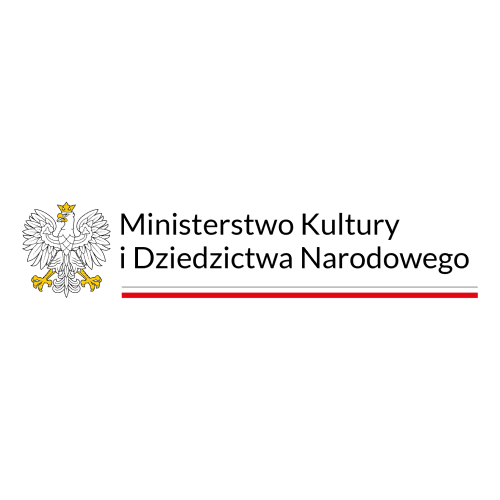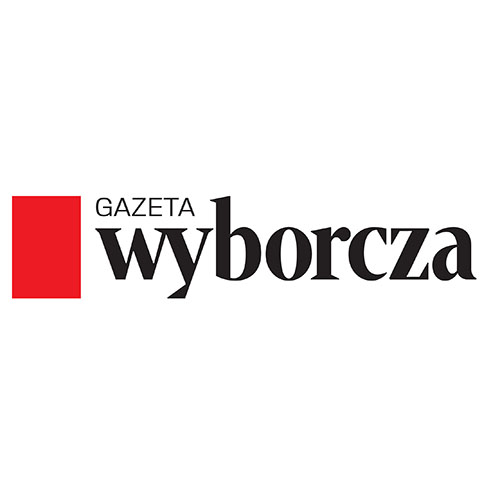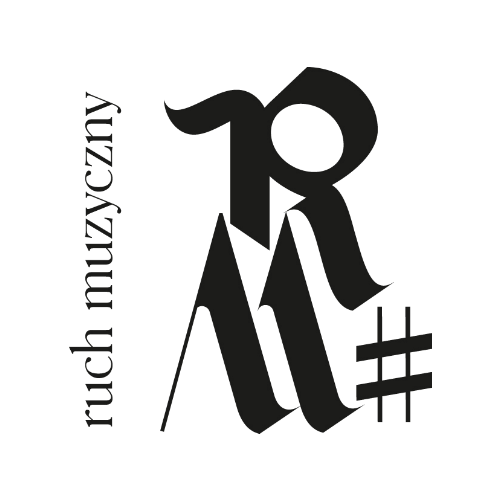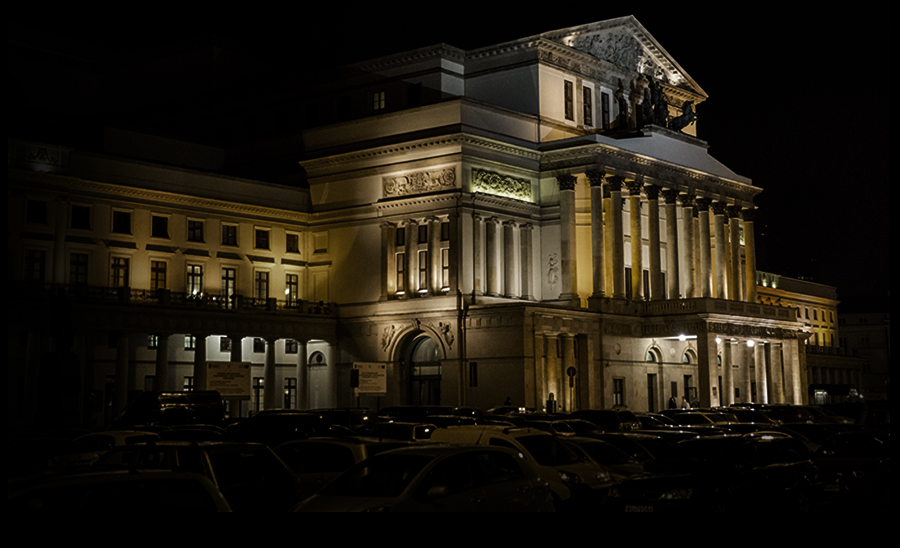La Bayadère
Ludwig Minkus / Marius Petipa, Natalia Makarowa
-
Act I
1 h 5 min.
-
Intermission
20 min.
-
Act II
45 min.
-
Intermission
20 min.
-
Act III
30 min.
Duration: ca. 3 h
-
See photo: [Translate to English:] fot. / photo: Ewa Krasucka
![[Translate to English:] fot. / photo: Ewa Krasucka [Translate to English:] fot. / photo: Ewa Krasucka](/fileadmin/_processed_/f/3/csm_001._Bajadera_IMG_6988_be3dc8ebca.jpg)
-
See photo: [Translate to English:] fot. / photo: Ewa Krasucka
![[Translate to English:] fot. / photo: Ewa Krasucka [Translate to English:] fot. / photo: Ewa Krasucka](/fileadmin/_processed_/d/c/csm_02._Bajadera_photo_Ewa_Krasucka_IMG_9253_2f3605bf95.jpg)
-
See photo: [Translate to English:] fot. / photo: Ewa Krasucka
![[Translate to English:] fot. / photo: Ewa Krasucka [Translate to English:] fot. / photo: Ewa Krasucka](/fileadmin/_processed_/6/1/csm_03._Bajadera_IMG_7232_a7ecb630bc.jpg)
-
See photo: [Translate to English:] fot. / photo: Ewa Krasucka
![[Translate to English:] fot. / photo: Ewa Krasucka [Translate to English:] fot. / photo: Ewa Krasucka](/fileadmin/_processed_/e/f/csm_04._Bajadera_IMG_7349_414a4a53b5.jpg)
-
See photo: [Translate to English:] fot. / photo: Ewa Krasucka
![[Translate to English:] fot. / photo: Ewa Krasucka [Translate to English:] fot. / photo: Ewa Krasucka](/fileadmin/_processed_/4/a/csm_05._Bajadera_IMG_7238_e4b140bd4d.jpg)
-
See photo: [Translate to English:] fot. / photo: Ewa Krasucka
![[Translate to English:] fot. / photo: Ewa Krasucka [Translate to English:] fot. / photo: Ewa Krasucka](/fileadmin/_processed_/b/0/csm_06._Bajadera_IMG_7207_94f2b3c539.jpg)
-
See photo: [Translate to English:] fot. / photo: Ewa Krasucka
![[Translate to English:] fot. / photo: Ewa Krasucka [Translate to English:] fot. / photo: Ewa Krasucka](/fileadmin/_processed_/c/7/csm_07._Bajadera_DSC_0108_a0b4abf7c3.jpg)
-
See photo: [Translate to English:] fot. / photo: Ewa Krasucka
![[Translate to English:] fot. / photo: Ewa Krasucka [Translate to English:] fot. / photo: Ewa Krasucka](/fileadmin/_processed_/2/5/csm_08._Bajadera_IMG_7310_efee4f555a.jpg)
-
See photo: [Translate to English:] fot. / photo: Ewa Krasucka
![[Translate to English:] fot. / photo: Ewa Krasucka [Translate to English:] fot. / photo: Ewa Krasucka](/fileadmin/_processed_/d/9/csm_09._Bajadera__IMG_2757_5c88b30e52.jpg)
-
See photo: [Translate to English:] fot. / photo: Ewa Krasucka
![[Translate to English:] fot. / photo: Ewa Krasucka [Translate to English:] fot. / photo: Ewa Krasucka](/fileadmin/_processed_/1/3/csm_10._Bajadera_IMG_9216_0370442577.jpg)
-
See photo: [Translate to English:] fot. / photo: Ewa Krasucka
![[Translate to English:] fot. / photo: Ewa Krasucka [Translate to English:] fot. / photo: Ewa Krasucka](/fileadmin/_processed_/6/0/csm_11._Bajadera_956-170_df0a7778c6.jpg)
-
See photo: [Translate to English:] fot. / photo: Ewa Krasucka
![[Translate to English:] fot. / photo: Ewa Krasucka [Translate to English:] fot. / photo: Ewa Krasucka](/fileadmin/_processed_/5/a/csm_12._Bajadera_IMG_7095_b9853cf46a.jpg)
-
See photo: [Translate to English:] fot. / photo: Ewa Krasucka
![[Translate to English:] fot. / photo: Ewa Krasucka [Translate to English:] fot. / photo: Ewa Krasucka](/fileadmin/_processed_/7/7/csm_13._Bajadera_IMG_7220_b1b11bac9e.jpg)
-
See photo: [Translate to English:] fot. / photo: Ewa Krasucka
![[Translate to English:] fot. / photo: Ewa Krasucka [Translate to English:] fot. / photo: Ewa Krasucka](/fileadmin/_processed_/7/0/csm_14._Bajadera_IMG_9307_9be29edfb0.jpg)
-
See photo: [Translate to English:] fot. / photo: Ewa Krasucka
![[Translate to English:] fot. / photo: Ewa Krasucka [Translate to English:] fot. / photo: Ewa Krasucka](/fileadmin/_processed_/7/f/csm_15._Bajadera_IMG_7195_67d05d788d.jpg)
-
See photo: [Translate to English:] fot. / photo: Ewa Krasucka
![[Translate to English:] fot. / photo: Ewa Krasucka [Translate to English:] fot. / photo: Ewa Krasucka](/fileadmin/_processed_/6/4/csm_16._Bajadera_0110_e18b484b87.jpg)
-
See photo: [Translate to English:] fot. / photo: Ewa Krasucka
![[Translate to English:] fot. / photo: Ewa Krasucka [Translate to English:] fot. / photo: Ewa Krasucka](/fileadmin/_processed_/6/a/csm_17._Bajadera_IMG_7348_2e981a497e.jpg)
-
See photo: [Translate to English:] fot. / photo: Ewa Krasucka
![[Translate to English:] fot. / photo: Ewa Krasucka [Translate to English:] fot. / photo: Ewa Krasucka](/fileadmin/_processed_/f/e/csm_18._Bajadera_fot._Ewa_Krasucka_IMG_9454_509c6d4b35.jpg)
-
See photo: [Translate to English:] fot. / photo: Ewa Krasucka
![[Translate to English:] fot. / photo: Ewa Krasucka [Translate to English:] fot. / photo: Ewa Krasucka](/fileadmin/_processed_/3/7/csm_19._Bajadera__956-160_ecb6cb2325.jpg)
-
See photo: [Translate to English:] fot. / photo: Ewa Krasucka
![[Translate to English:] fot. / photo: Ewa Krasucka [Translate to English:] fot. / photo: Ewa Krasucka](/fileadmin/_processed_/d/6/csm_20._Bajadera_IMG_7111_d2e37365a0.jpg)
-
See photo: [Translate to English:] fot. / photo: Ewa Krasucka
![[Translate to English:] fot. / photo: Ewa Krasucka [Translate to English:] fot. / photo: Ewa Krasucka](/fileadmin/_processed_/d/f/csm_21._Bajadera_IMG_7208_4895c87e0a.jpg)
-
See photo: [Translate to English:] fot. / photo: Ewa Krasucka
![[Translate to English:] fot. / photo: Ewa Krasucka [Translate to English:] fot. / photo: Ewa Krasucka](/fileadmin/_processed_/7/5/csm_22._Bajadera_fot._Ewa_Krasucka_IMG_9504_be569dd898.jpg)
-
See photo: [Translate to English:] fot. / photo: Ewa Krasucka
![[Translate to English:] fot. / photo: Ewa Krasucka [Translate to English:] fot. / photo: Ewa Krasucka](/fileadmin/_processed_/1/f/csm_23._Bajadera_IMG_9004_b242e0bd2f.jpg)
-
See photo: [Translate to English:] fot. / photo: Ewa Krasucka
![[Translate to English:] fot. / photo: Ewa Krasucka [Translate to English:] fot. / photo: Ewa Krasucka](/fileadmin/_processed_/d/d/csm_24._Bajadera_IMG_9447_c4e5874ebd.jpg)
-
See photo: [Translate to English:] fot. / photo: Ewa Krasucka
![[Translate to English:] fot. / photo: Ewa Krasucka [Translate to English:] fot. / photo: Ewa Krasucka](/fileadmin/_processed_/6/2/csm_25._Bajadera_0152_7ca4dd2c74.jpg)
Ballet in three acts
Libretto: Marius Petipa, Sergei Khudyakov
Music: Ludwig Minkus
Arranged by: John Lanchbery
World premiere: Bolshoi Theatre, 4 February 1877
Premiere of this production: American Ballet Theatre, New York, 21 May 1980
Premiere in the Teatr Wielki – Polish National Opera: 15 May 2004
A beautiful Hindu tale of love and its power to transcend death. The legendary ballet star Natalia Makarova staged La Bayadère at Teatr Wielki according to the best St. Petersburg standards. She meticulously recreated and polished the original choreographic version of the great Marius Petipa from 1877, while retaining his original unmatched choreography of the Kingdom of the Shades scene – one of the most phenomenal pieces in classical ballet heritage. She first created her La Bayadère for the American Ballet Theatre in New York, and then revived it several times with the best classical dance companies. This colourful, romantic show captivates the audience with its scale; it is deeply moving and leaves a lasting impression. It is full of wonderful solo performances and ensemble scenes. It is an excellent test of academic craftsmanship of every ballet company. Also the Polish National Ballet and its leading soloists.
Cast
- Nikiya
- Solor
- The High Brahmin
- The Golden Idol
- The Rajah
- Gamzatti
-
Magdaveya
 Kasper Górczak
Kasper Górczak
(debuting in the role)
-
- Nikiya
- Solor
- The High Brahmin
- The Golden Idol
- The Rajah
- Magdaveya
- Gamzatti
-
Solor
 Marko Juusela
Marko Juusela
(debuting in the role) -
Gamzatti
 Hannah Cho
Hannah Cho
(debuting in the role) -
The High Brahmin
 Nikodem Bialik
Nikodem Bialik
(debuting in the role) - The Golden Idol
- The Rajah
- Magdaveya
-
- Nikiya
- Nikiya
- Solor
- Gamzatti
- The High Brahmin
- The Golden Idol
- The Rajah
-
Magdaveya
 Kasper Górczak
Kasper Górczak
-
- Nikiya
- Solor
- The High Brahmin
- The Golden Idol
- The Rajah
- Magdaveya
- Gamzatti
-
Solor
 Marko Juusela
Marko Juusela
-
Gamzatti
 Hannah Cho
Hannah Cho
- The High Brahmin
- The Golden Idol
- The Rajah
- Magdaveya
-
- Nikiya
- Nikiya
- Solor
- Gamzatti
- The High Brahmin
-
The Golden Idol
 Marko Juusela
Marko Juusela
(debuting in the role) - The Rajah
- Magdaveya
- Nikiya
- Solor
-
Gamzatti
 Yana Shtanhei
Yana Shtanhei
(debuting in the role) - The High Brahmin
-
The Golden Idol
 Alan Polański
Alan Polański
(debuting in the role) - The Rajah
- Magdaveya
- Nikiya
- Solor
- Gamzatti
- The High Brahmin
-
The Golden Idol
 Marko Juusela
Marko Juusela
- The Rajah
- Magdaveya
- Nikiya
- Solor
-
Gamzatti
 Yana Shtanhei
Yana Shtanhei
-
The High Brahmin
 Nikodem Bialik
Nikodem Bialik
- The Golden Idol
- The Rajah
- Magdaveya
Credits
- Choreography after Marius Petipa
- Conductor (17, 19, 21-23/11)
- Set and costume designer
- Lighting
- Conductor (18/11; 20-23/12)
- Choreography after Marius Petipa
- Conductor (17, 19, 21-23/11)
- Set and costume designer
- Lighting
- Conductor (18/11; 20-23/12)
- Choreography after Marius Petipa
- Conductor (17, 19, 21-23/11)
- Set and costume designer
- Lighting
- Conductor (18/11; 20-23/12)
- Choreography after Marius Petipa
- Conductor (17, 19, 21-23/11)
- Set and costume designer
- Lighting
- Conductor (18/11; 20-23/12)
- Choreography after Marius Petipa
- Conductor (17, 19, 21-23/11)
- Set and costume designer
- Lighting
- Conductor (18/11; 20-23/12)
- Choreography after Marius Petipa
- Conductor (17, 19, 21-23/11)
- Set and costume designer
- Lighting
- Conductor (18/11; 20-23/12)
- Choreography after Marius Petipa
- Conductor (17, 19, 21-23/11)
- Set and costume designer
- Lighting
- Conductor (18/11; 20-23/12)
- Choreography after Marius Petipa
- Conductor (17, 19, 21-23/11)
- Set and costume designer
- Lighting
- Conductor (18/11; 20-23/12)
- Choreography after Marius Petipa
- Conductor (17, 19, 21-23/11)
- Set and costume designer
- Lighting
- Conductor (18/11; 20-23/12)
- Choreography after Marius Petipa
- Conductor (17, 19, 21-23/11)
- Set and costume designer
- Lighting
- Conductor (18/11; 20-23/12)
Polish National Ballet
Orchestra of the Teatr Wielki – Polish National Opera
Synopsis
-
Act I
Scene 1. The Sacred Forest, outside the temple
Warriors
returning from the great tiger hunt are joined by Solor, the noblest
warrior in the land. He asks to be left alone to pray before the Sacred
Fire, but once the warriors have departed, he calls for the head Fakir,
Magdaveya, and asks him to arrange a rendezvous for him with the
bayadère, Nikiya. They are interrupted by the arrival of the priests and
the High Brahmin who orders Magdaveya to gather the other Fakirs to
prepare the Sacred Fire for the coming celebration. The bayadères
appear, and among them is Nikiya, who has been chosen to be consecrated
their leader. The High Brahmin is overwhelmed by her beauty and tells
Nikiya of his love for her. Nikiya, however, rejects his attentions for
he is a man of God. The High Brahmin is deeply hurt by her reaction to
his declaration of love. As the celebration begins, the temple dancers
bring water to the Fakirs, and Magdaveya informs Nikiya of Solor’s
message. Nikiya agrees to meet him, but not before the High Brahmin has
seen her with Magdaveya and becomes suspicious. The ceremony ends and
the celebrants return to the temple. Magdaveya calls for Solor and tells
him to hide in the forest until Nikiya returns to meet him. She soon
appears, and when Solor joins her they swear eternal love over the
Sacred Fire. Unbeknown to Solor and Nikiya, the High Brahmin has been
watching them from within the temple, and after an uneasy Magdaveya
separates the lovers, the High Brahmin emerges in a fury and invokes the
gods to help him kill Solor.
Scene 2. A room in the palace
Warriors
have been invited to the palace to honour Solor. The Rajah announces
that Solor’s reward for his valour will be marriage to Gamzatti. He
presents his daughter to Solor, and when he lifts her veil, Solor is
overcome by her beauty. Even though he has sworn eternal love to Nikiya,
he cannot resist Gamzatti’s attractions or refuse the Rajah’s wishes.
Entertainment is provided for the betrothed couple, which ends with the
arrival of the High Brahmin. He asks to speak privately to the Rajah,
and informs him of Nikiya’s and Solor’s love. He had hoped that the
Rajah would kill Solor, but the Rajah instead decides that Nikiya must
die, to the dismay of the High Brahmin. Gamzatti overhears their
conversations and summons Nikiya to her rooms. She tries to bribe her to
leave Solor by offering her jewels and gifts, but Nikiya refuses. In
desperation, she tries to stab Gamzatti, but is stopped by her
attendant, Aya. As Nikiya runs out of the room, Gamzatti, like her
father, determines to kill her.
Scene 3. The garden of the palace
Festivities
are presented in honour of the betrothal of Gamzatti and Solor. The
High Brahmin brings Nikiya to dance for the ceremony. She cannot accept
the engagement and expresses her sadness in dance. Aya gives her a
basket of flowers which she says are from Solor, and Nikiya’s spirits
brighten. However, a poisonous snake is hidden among the flowers, which
were actually sent by the Rajah and Gamzatti. The snake bites Nikiya as
she lifts the basket to smell the flowers. The High Brahmin offers her
an antidote to the poison, but the moment before she drinks it, Nikiya
sees Solor being led away by the Rajah and Gamzatti, and she decides to
die.
-
Act II
Scene 1. Solor’s tent
Despondent and depressed by Nikiya’s death, Solor smokes opium, given to him by agdaveya to deaden his grief.
Scene 2. The Kingdom of the Shades
Solor
hallucinates and conjures a vision of the dead Nikiya. She appears in
the Kingdom of the Shades, and her vision is multiplied by the corps de
ballet. Solor reminisces about her dance of love by the Sacred Fire.
Scene 3. Solor’s tent
As
the warriors enter his tent to prepare Solor for the wedding to
Gamzatti, the vision of Nikiya continues to haunt and confuse him.
-
Act III
The temple
In the shadow of the Great Buddha, a bronze idol dances as the High Brahmin and the priests prepare for the wedding of Gamzatti and Solor. The betrothed couple enter, and the bayadères perform a ritual candle dance round them, reminiscent of the Sacred Fire burning outside the temple. The Rajah, Gamzatti and Solor dance, but Solor is haunted by the vision of Nikiya, which is visible only to him. During the dance, a basket of flowers identical to the one given to Nikiya mysteriously appears, and Gamzatti, terrified and consumed with guilt, urges her father to complete the wedding ceremony. The High Brahmin performs the ceremony on the steps of the altar, but Solor cannot force himself to say the vows. The infuriated gods destroy the temple and bury everyone under its ruins. The spirits of Nikiya and Solor are reunited in eternal love.
Sponsors
-
- Patrons of the Polish National Opera | Partners of the Opera Academy
-
- Partners of the Polish National Opera
-
- Partner of the Polish National Ballet
-
- Media patrons
-
- Media partner



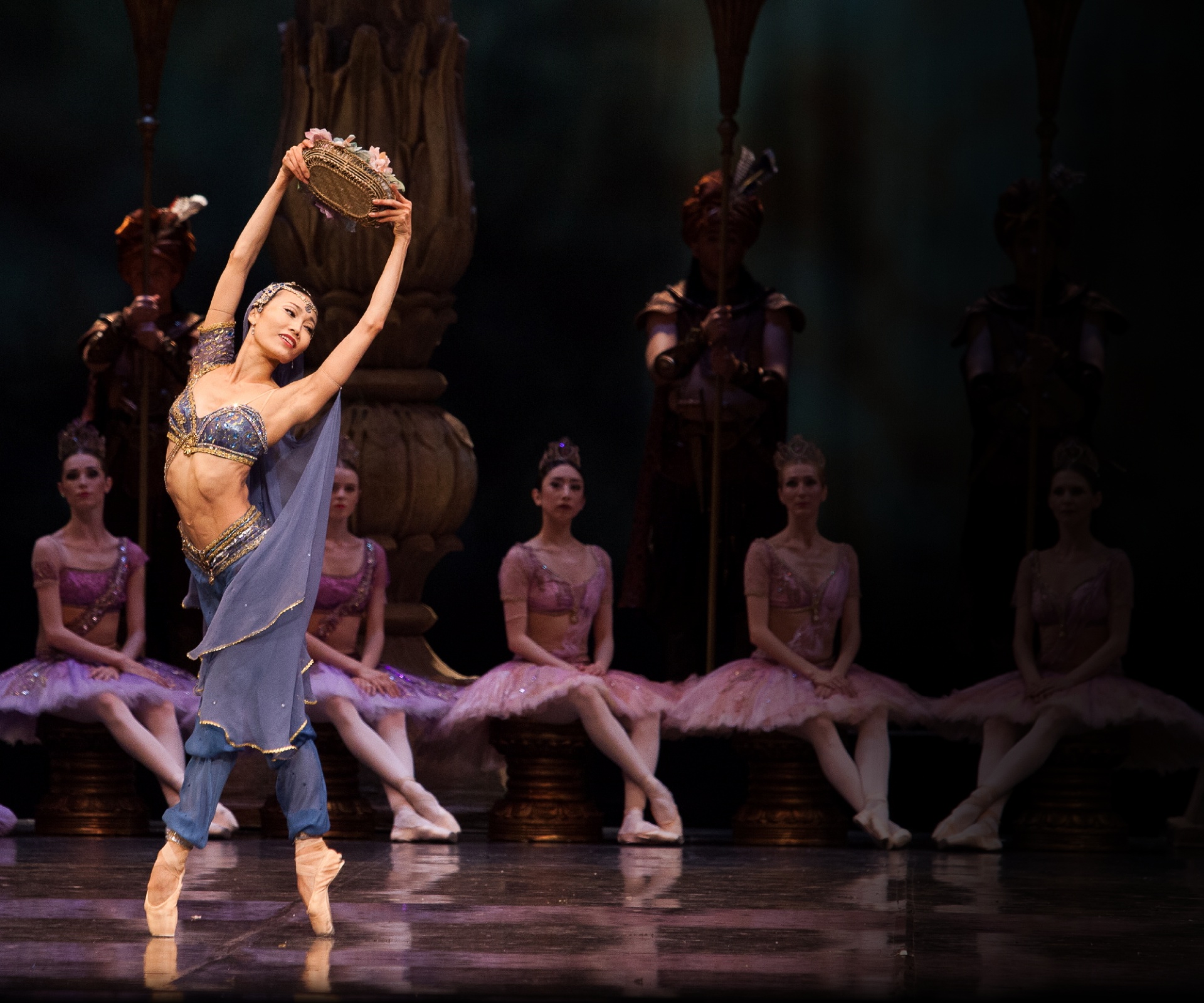
![[Translate to English:] [Translate to English:]](/fileadmin/_processed_/b/9/csm_Bajadera_-_Polski_Balet_Narodowy_b2171db793.png)
 Chinara Alizade
Chinara Alizade
 Vladimir Yaroshenko
Vladimir Yaroshenko
 Wojciech Ślęzak
Wojciech Ślęzak
 Ryota Kitai
Ryota Kitai Gregor Giselbrecht
Gregor Giselbrecht Evelina Godunova
Evelina Godunova Yuka Ebihara
Yuka Ebihara
 Patryk Walczak
Patryk Walczak Marco Esposito
Marco Esposito Laurence Elliott
Laurence Elliott Paweł Koncewoj
Paweł Koncewoj
 Diogo de Oliveira
Diogo de Oliveira Łukasz Tużnik
Łukasz Tużnik Cezary Wąsik
Cezary Wąsik Mai Kageyama
Mai Kageyama![[Translate to English:]](/fileadmin/_processed_/8/2/csm_Jaeeun_Jung__fot._Justyna_Mielniczuk_www2_66a55508d2.jpg) Jaeeun Jung
Jaeeun Jung Natalia Makarowa
Natalia Makarowa
 Alexei Baklan
Alexei Baklan
 Jadwiga M. Jarosiewicz
Jadwiga M. Jarosiewicz
 Stanisław Zięba
Stanisław Zięba
![[Translate to English:]](/fileadmin/_processed_/b/4/csm_Marta_Kluczynska_fot_karpati_zarewicz_kwadrat_fde347331b.jpg) Marta Kluczyńska
Marta Kluczyńska
